





Muhammad Arshad Eyasim, Sudesh Sivarasu
ORCID ID: 0000-0001-9571-6586, 0000-0002-0812-568X
Division of Biomedical Engineering
Department of Human Biology
University of Cape Town
Western Cape
South Africa
Patients suffering from Covid-19 and Chronic Obstructive Pulmonary Disease (COPD), or asthma comorbidities receive Continuous Positive Airway Pressure (CPAP) therapy as one of the treatment options. They additionally require regular administration of a bronchodilator medication using a Metered Dose Inhaler (MDI) to open the airways of the lungs to make breathing easier. However, some challenges have been identified with existing techniques of using MDI with CPAP; a nurse must remain at the bedside to manually time the actuations and actuate the MDI. One of the current methods does not provide Positive End-Expiratory Pressure (PEEP), thereby reducing the medication's effectiveness. The current global Covid-19 pandemic has resulted in the limited number of Intensive Care Unit (ICU) resources such as bedside nurses and ventilators. Therefore, a need for a device that can provide oxygenation and automated MDI medication delivery has been identified to reduce the number of ICU admissions, increase the effectiveness of MDI treatment, and reduce the number of patients requiring intubation. This design project entails the development of a prototype as well as verification and validation tests. The prototype was built by focusing on the functional blocks and iterating the core component of the design. The prototype was then verified and validated. It was found the Proof of Concept of the device meets the requirements and works as intended. In conclusion, the project highlights how the needs are met and the drawbacks of the design are identified. Recommendations are then made on the improvement of the device's functionality and usability features.
Keywords: CPAP, MDI, Bronchodilator, Automated, Covid-19, COPD, Asthma
| COPD | Chronic Obstructive Pulmonary Disease |
| CPAP | Continuous Positive Airway Pressure |
| FiO2 | Fraction of Inspired Oxygen |
| ICU | Intensive Care Unit |
| MDI | Metered Dose Inhaler |
| PEEP | Positive End-Expiratory Pressure |
The number of cases in the current global Covid-19 pandemic is on the rise, and many of these patients have COPD or asthma comorbidities. Pneumonia and Hypoxemia in Covid-19 patients with pre-existing illnesses such as COPD or asthma are the disease state fundamentals of interest within the target group. Many people in the target group require oxygen therapy, such as CPAP therapy, as well as the delivery of a bronchodilator using an MDI. The MDI delivery is currently conducted using two methods. The first technique, shown in Figure 1, employs an inline MDI T-piece adaptor, which requires a nurse to manually time and actuate the MDI. The second approach, shown in Figure 2, necessitates the removal of the mask to administer the drug orally using an MDI spacer.
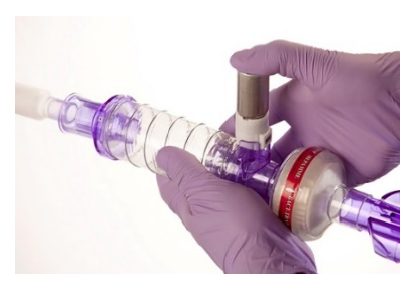
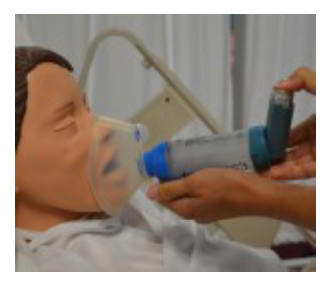
A study on the severity and mortality associated with COPD and smoking in patients with Covid-19 found that COPD patients had a higher severity risk of 63% compared to patients without COPD with a severity risk of 33.4%, and Covid-19 patients with COPD have a higher mortality rate of 60% (Alqahtani et al., 2020). Africa has the second highest prevalence of COPD in the world and Cape Town has the highest COPD prevalence in Africa (Blanco et al., 2019). The symptoms are worse for people who already have asthma when they are infected with the Covid-19 virus (Wiginton, 2021). Based on a recent study by Naidoo & Naidoo (2021) on scarce ICU resources, they found that approximately 16% of Covid-19 infected cases require ICU admission and that this percentage in a South African setting will put additional pressure on the country’s ICU resources which are already in usage by other patients with medical conditions that require ICU support. Thus, the need statement formulated to address the problem identified is a way of addressing the delivery of MDI medication using a CPAP device by integrating an automated MDI delivery system, allowing for a decreased number of ICU admission, increased effectiveness of MDI treatment and a decreased number of patients requiring intubation.
Currently, there is no commercial solution available to address the identified issue. The proposed solution is a CPAP device with oxygenation and an automated MDI delivery system. This device allows users to set CPAP and MDI settings such as inspiratory pressure, dosing frequency, and dosing interval. A prototype is to be built, verified and validated. The prototype must meet all user and design requirements, identified needs, and Proof of Concept.
The design thinking 6-3-5 brainstorming method (Wilson, 2013) was used amongst six participants to ideate on various components of the device. The best ideas were collated, and nine concepts were generated. A final concept was obtained after selecting and screening the concepts.
After obtaining the final concept, functional blocks were identified based on the needs criteria for the preliminary step in the prototype development. The functional blocks are: a fan that can provide adjustable continuous pressure, a way to adjust and determine Fraction of Inspired Oxygen (FiO2), an automated MDI delivery system, an easily accessible and reloadable medication canister, supplied air must be warmed and humidified, the device must provide PEEP and have safety features.
The technical specifications of the prototype are drawn using the specifications prescribed by the World Health Organization for non-invasive ventilators for Covid-19 (2020) as shown in Table 1.

The initial design iteration was conducted on the fan outlet, shown in Figure 3.

The internal diameter was changed to 22mm after Design 2 to maintain a constant diameter across the system to minimise pressure drops. It was found that Design 4 is the best with the lowest backpressure and smoother readings.
The first iteration uses a lever arm that is placed directly on the canister end. When the lever rotates, it will press against the canister and actuate it. This design failed as the torque was too small causing the lever arm to be stuck on the canister end. The second iteration uses a slider-crank mechanism whereby the slider presses against the canister and actuates it. This design also failed as the force exerted onto the canister was too small. Servos with higher torque specifications were tried, but they also did not work. The last iteration uses a cam actuation mechanism to actuate the canister, as shown in Figure 4.
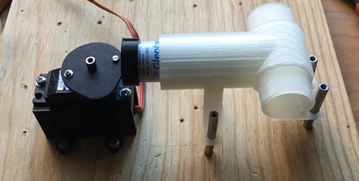
This mechanism worked well. However, a cap had to be placed on the canister to enable actuation. Without the cap, the nose of the cam is jammed in the concave surface of the canister.
After all the iterations, coding, and components layout, the prototype was finally assembled using various off-the-shelf and 3D printed parts. Figure 5 shows the UI, the PEEP valve and the sliding door, Figure 6 shows the air inlet filter, Figure 7 shows the power and oxygen inlet and Figure 8 shows the dual circuitry ports.
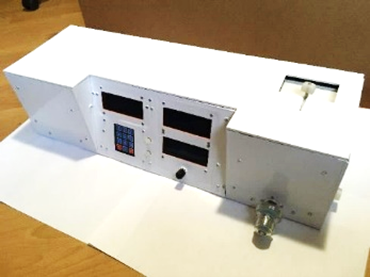
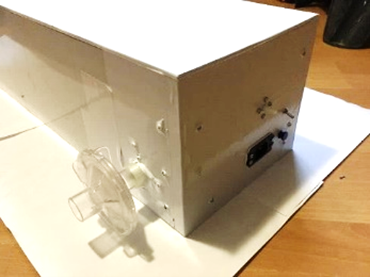
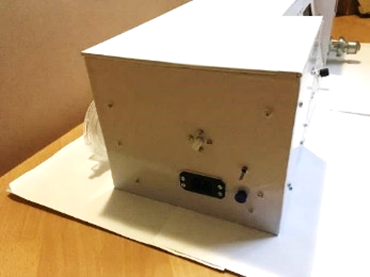
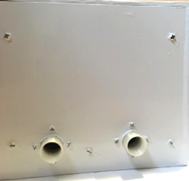
An Arduino Mega ATmega2560 microcontroller is used in the device as the controls system. Figure 9 shows the electrical layout of the Arduino connections with the other electronics.
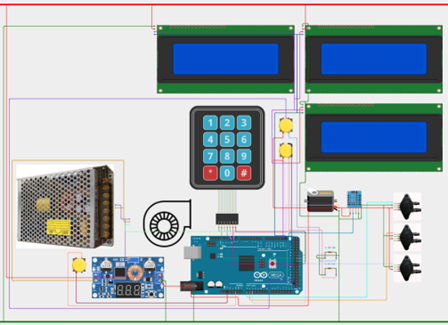
A DHT11 temperature and humidity sensor is used to monitor the temperature and humidity of the supplied air. The first pressure sensor is used in the feedback loop to regulate the CPAP settings. The second and third pressure sensors are used to measure the differential pressure across the Venturi flow meter along the air and oxygen stream respectively to in turn calculate the flow rate of gas in each stream.
A low pass noise filter was used for the pressure readings. Figure 10 shows the results from pressure readings before and after applying the low-pass noise filter.

Graph 1 shows that before applying the low-pass noise filter, the readings are very noisy. After applying the filter, the readings are smoother.
The verification test for the pressure specifications was conducted at the minimum pressure setting of 3 cmH2O and the maximum pressure setting of 20 cmH2O at a minimum PEEP of 5 cmH2O and a maximum PEEP of 20 cmH2O for each test. However, for a user input of 20 cmH2O, the fan was not able to achieve this pressure at its maximum speed due to its specifications. Thus, the pressure range that can currently be achieved is 3 to 13 cmH2O. This is mainly due to the fan specifications which can be changed for a higher specification fan.
The pressure is validated by comparing the pressure output of the device to the pressure supplied to the mask by measuring the pressure at the end of the circuitry which would be the same as the pressure delivered to the mask. Figure 11 shows the results.
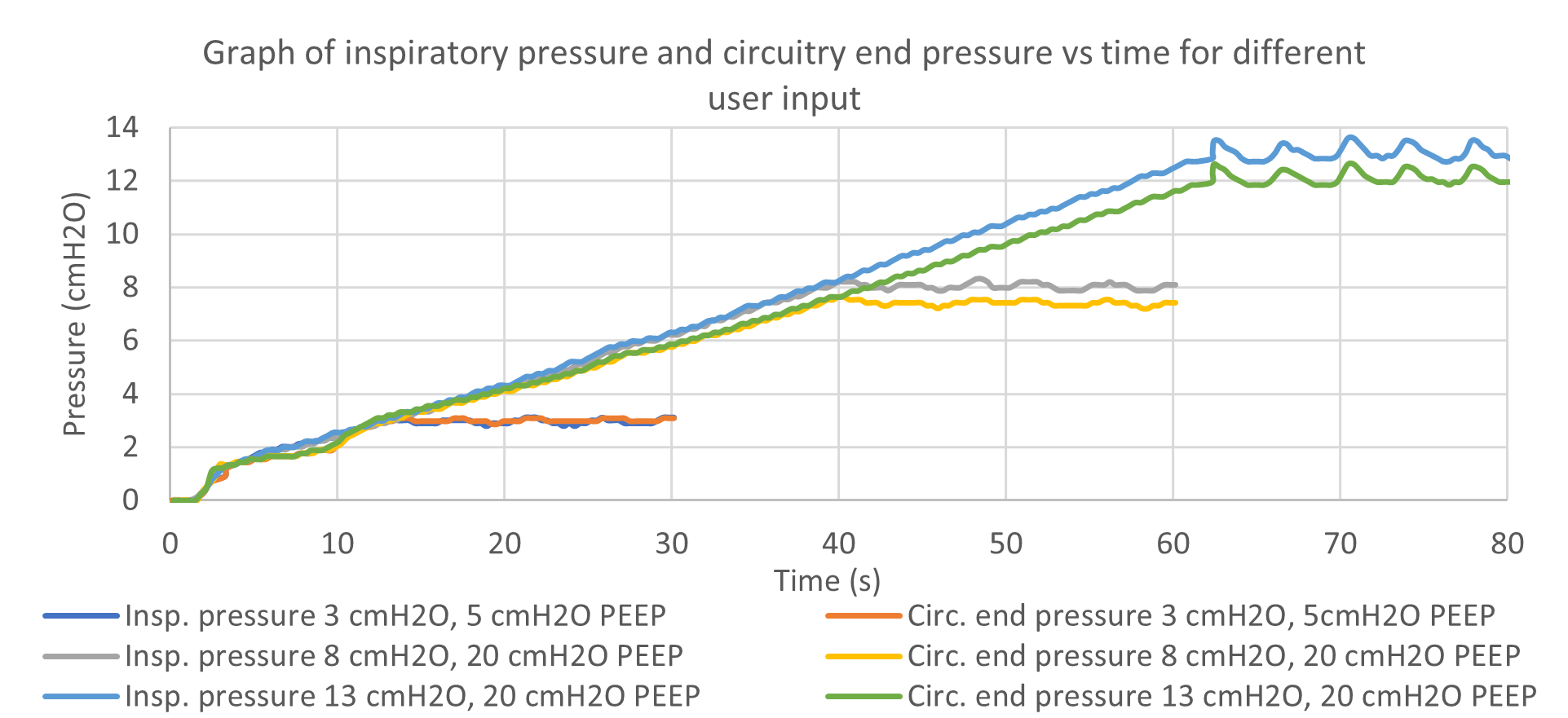
Figure 11 shows that the inspiratory pressure is very close to the pressure at the circuitry end. However, the difference between the inspiratory and circuitry end pressure increases slightly with increasing inspiratory pressure. This difference can be accounted for by calibrating the fan. Hence, the inspiratory pressure produced, based on the user input, is validated as the pressure at the circuitry end is very close to the user input pressure.
The MDI actuations were verified using the Arduino IDE serial plotter feature. Figure 10 shows the results for user input settings of two for the number of dosages and six seconds for the interval between dosages.
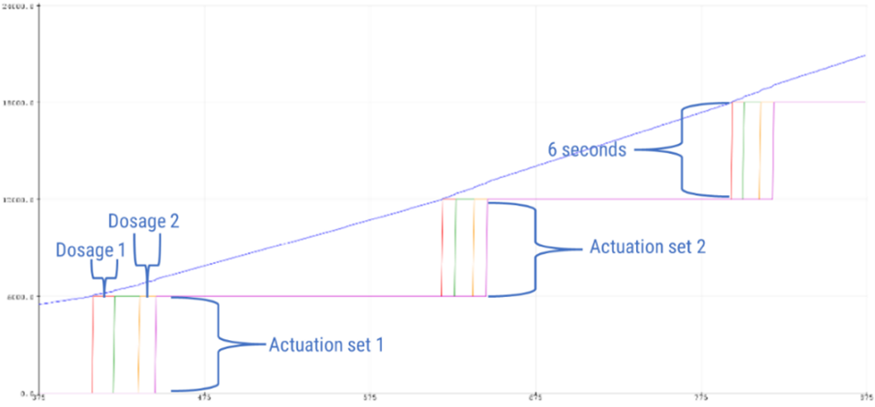
Figure 12 shows that the servo is actuated two times every six seconds. The MDI actuation test was conducted with a range of user input settings for the number of dosages and interval between dosages. It was found that the actuation of the MDI is working as intended based on the user input settings. The actuation of the MDI based on the user input settings is validated by testing the actuation at different user inputs and by visually confirming that the actuation occurred.
The validation was conducted by inputting a wide range of settings for the actuations and intervals between the actuations. The actuation was visually confirmed, and the serial monitor on the Arduino IDE software was then used to check the time. Thus, for each setting, when the servo was actuated, the “actuated” print and timestamp on the serial monitor of the Arduino IDE interface was also checked and found to be working as intended.
Due to the scope of this project, the prototype was not tested with actual oxygen, but with air instead. Equation 1 was used to plot Figure 13 using the airflow rate at these specific pressures and using the standard oxygen wall supply flow rate of hospitals, which ranges from 0 to 15 Lpm (Ely & Clapham, 2003).

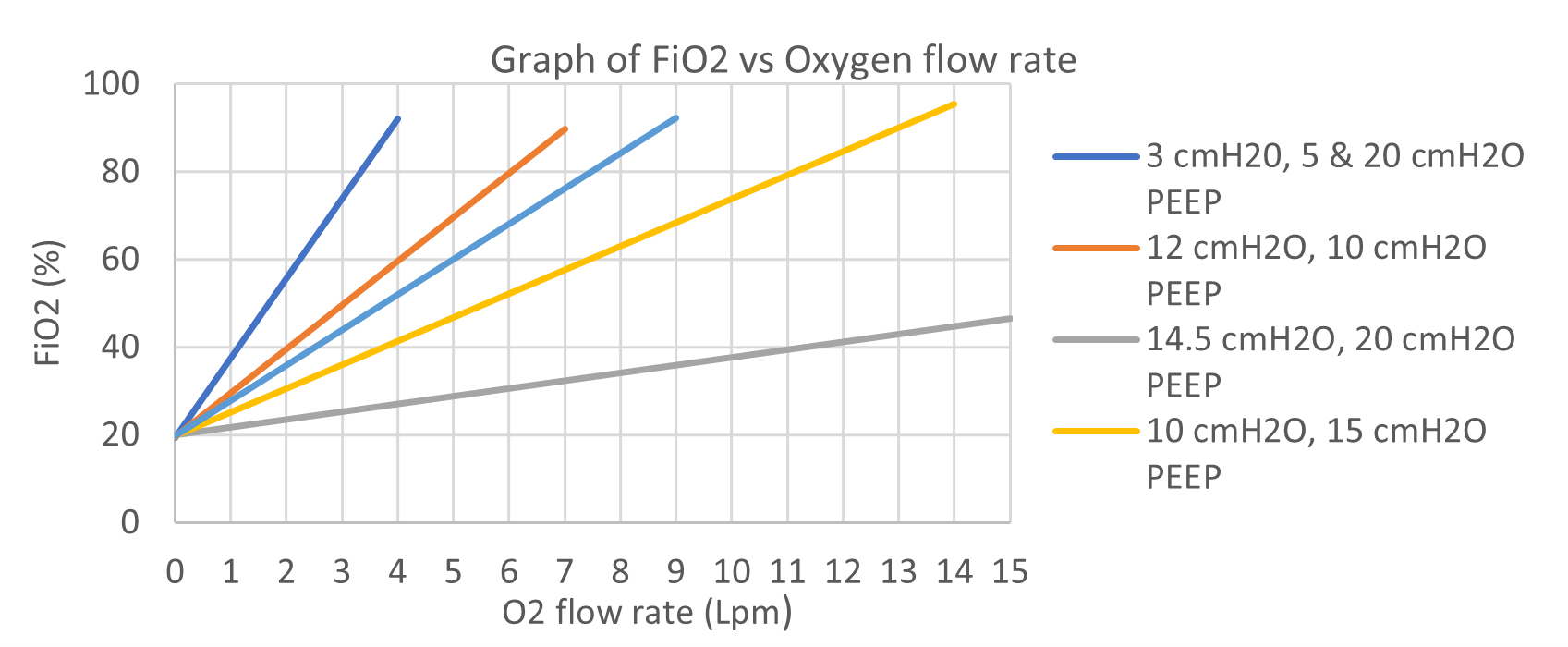
Figure 13 shows a linear relationship between FiO2 and oxygen flow rate. This graph is derived using air only. That is, right now 10 cmH2O user input is achieved from air only, whereas in actual use with oxygen, the 10 cmH2O would be a combination of the pressure exerted by the air-oxygen mixture which will together equal 10 cmH2O. Therefore, in actual use, a user input of 10 cmH2O means a lower pressure from the air supply, which would also be represented by a line of lower pressure in the current graph. Since all the pressure lines have the same relationship, the relationships between FiO2 and oxygen flow rate in the current graph will still be valid in actual use, but at lower pressures.
As actual oxygen was not used for the tests, a secondary air source was used in place of oxygen to test for FiO2. At the time of validation, few possible air sources were tested to be used instead of oxygen due to availability. However, their flow rates were higher or lower than the standard medical oxygen flow rates of 3 to 15 Lpm. Thus, to validate the FiO2, an outlet air bypass was used at the circuitry which was then directed to the oxygen inlet of the air stream inside the device. The setup was then tested using different user inputs and the data on air and ‘oxygen’ flowrates were recorded and the FiO2 was calculated using equation (1). Figure 14 shows the FiO2 obtained for different user input pressures at 20 cmH2O PEEP.
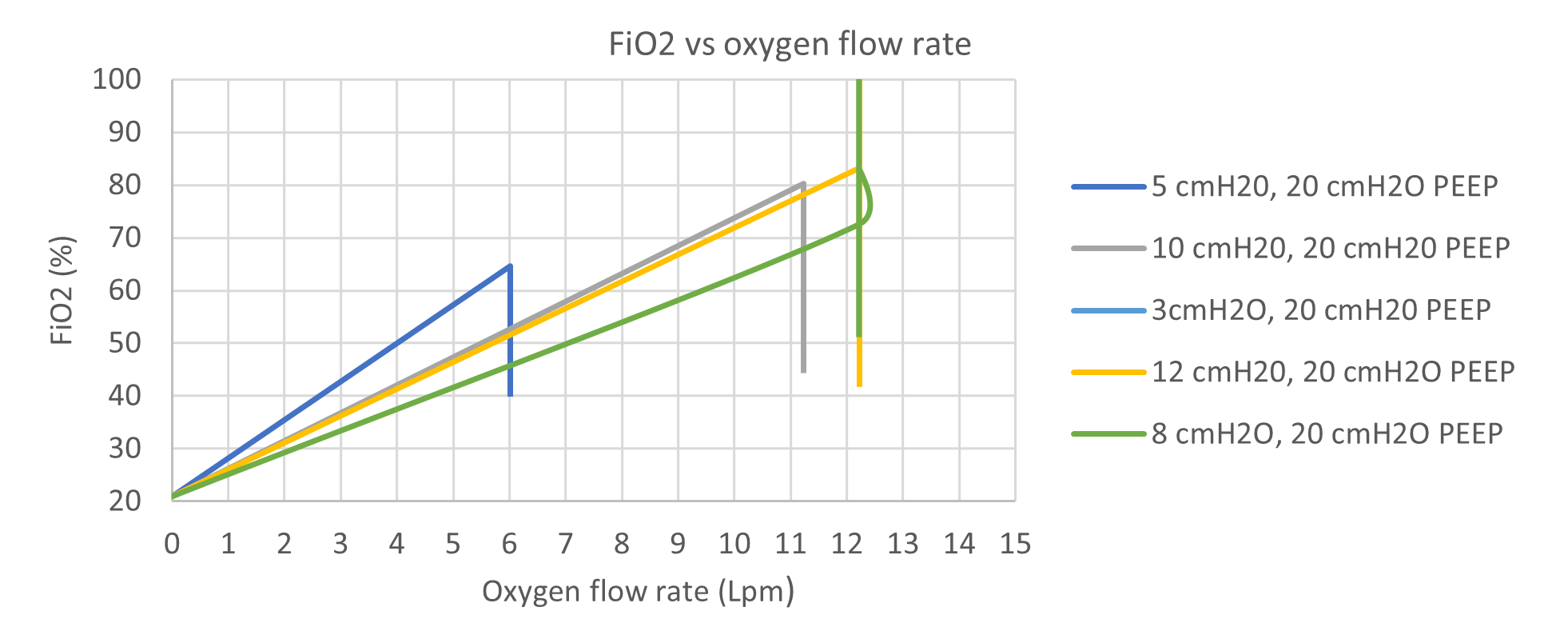
This graph shows the results for the FiO2 at different pressure and O2 flow rates. At each flow rate, the line was extended to 0 Lpm, 21%. The graph shows that at any user input, increasing the oxygen flow rate increases the FiO2 and the fan simultaneously adjusts its speed to match the pressure and flow rate required to achieve the FiO2 and pressure.
The Proof of Concept of the prototype was met by verifying and validating whether the device can provide continuous pressure, actuate the MDI and adjustable FiO2 based on user input. The maximum inspiratory pressure range that can currently be achieved with the device is 3 to 13 cmH2O. It was also found that with increasing pressure the pressure at the mask is slightly lower than the output of the device. This pressure drop is expected and can be calibrated by increasing the output pressure of the device slightly higher than the user input pressure so that the pressure at the mask is the same as the user input. The MDI actuation device was found to be working effectively and accurately in respect to time. Theoretically, it was verified that the adjustable FiO2 will work. The test was then validated showing that the verification test and the validation test graphs are very similar. Thus, the working principle of this concept works. Hence, the Proof of Concept of the device was successfully met.
The total cost of prototyping was R5 667. Considering the mass production of the device and various parts, the cost is expected to be reduced to R 4000. Thus, with a 25% markup, the retail price of the device to distributors will be R5 000. The developed device is cheaper than traditional CPAP devices without oxygenation, which cost upwards of R 8 900, but it is more expensive than CPAP devices that use air entrainment such as the Nippy 3+ or CPAP masks that cost upwards of R 4 800 and R 1 200 respectively (Afrimedics, 2021; Dotmed, 2021; Medex Supply, 2021). The device developed, which integrates an automated MDI delivery system, is thus considered to be cost-effective compared to both the cheaper and more expensive CPAP devices as they do not include the MDI delivery system. The cheaper CPAP devices have many limitations such as restricted flow rate in the Nippy 3+, and no display to monitor various parameters and fixed FiO2 with CPAP masks.
The drawbacks of the prototype are that the accuracy and sensitivity of the pressure sensors are unreliable, the fan specifications are too low for this application, the prototype is very large, it needs to be reset at power up for the Arduino to work and the reloadability of the MDI canister is not user-friendly.
Based on the prototype, the following recommendations on the improvement of the device are made: a way to substitute the cap needed for the MDI canister by using a different cam design that will not get jammed in the canister’s concave end, a standard off-the-shelf flowmeter can be used for better accuracy and reliability, the flow dynamics of the device must be analysed and improved to increase the efficiency of the pressure delivery, the sliding door can be motorised for ease of use and to ensure it is closed fully, the reloading of the canister can also be improved by using an actuator that pushes the canister out for reloading and lastly, the device can be improved to detect inspiration and then actuate the MDI after the interval set.
A Proof of Concept for a CPAP device with oxygenation and an automated MDI delivery system has been successfully designed and developed. The device has been tested and validated to show that it works as intended. Based on its additional features, the device is cost-effective compared to existing solutions. This project presented a methodology that can be used for further iterations to create improved commercial solutions. Further improvements were recommended to adapt the design to the global market in terms of functionality and ease of use.
The authors would like to thank members of the Medical Devices lab at the University of Cape Town and merSETA for the ViroVent Innovation Challenge.
Afrimedics. (2021). Portable auto Cpap Machine DS-6 AUTO CPAP. Retrieved 25 September 2021, from https://www.afrimedics.co.za/product/portable-auto-cpapmachine- ds-6- autocpap/?sfdr_ptcid=13621_617_673695122&sfdr_hash=d18ffb68f5f2948fd794621 db2bb5562
Alqahtani, J., Oyelade, T., Aldhahir, A., Alghamdi, S., Almehmadi, M., & Alqahtani, A. et al. (2020). Prevalence, Severity and Mortality associated with COPD and Smoking in patients with COVID-19: A Rapid Systematic Review and Meta- Analysis. PLOS ONE, 15(5), e0233147. doi: 10.1371/journal.pone.0233147
Armstrong Medical. (2021). Spirale® Drug Delivery System. Retrieved 20 September 2021, from https://www.armstrongmedical.net/product/spirale/
Blanco, I., Diego, I., Bueno, P., Casas-Maldonado, F., & Miravitlles, M. (2019). Geographic distribution of COPD prevalence in the world displayed by Geographic Information System maps. European Respiratory Journal, 54(1), 1900610. doi: 10.1183/13993003.00610-2019
Dotmed. (2021). For Sale NIPPY 3+ Ventilator. Retrieved 26 September 2021, from https://www.dotmed.com/listing/ventilator/nippy/3+/2281165
Doyle, G., & McCutcheon, J. (2021). Clinical Procedures for Safer Patient Care. Retrieved 20 October 2021, from https://opentextbc.ca/clinicalskills/chapter/inhaled-and-topical-medications/
Ely, J., & Clapham, M. (2003). Delivering oxygen to patients. BJA CEPD Reviews, 3(2), 43-45. doi: 10.1093/bjacepd/mkg011
Medex Supply. (2021). Flow Safe II CPAP with large adult mask 5/Box. Retrieved 16 October 2021, from https://medexsupply.com/flow-safe-ii-cpap-with-large-adult-mask-5-box/?pid=104260
Naidoo, R., & Naidoo, K. (2021). Prioritising ‘already-scarce’ intensive care unit resources in the midst of COVID-19: a call for regional triage committees in South Africa. BMC Medical Ethics, 22(1). doi: 10.1186/s12910-021-00596-5
Technical specifications for invasive and non-invasive ventilators for COVID- 19. Apps.who.int. (2020). Retrieved from https://apps.who.int/iris/rest/bitstreams/1275111/retrieve
Wiginton, K. (2021). Coronavirus and Asthma. WebMD. Retrieved from https://www.webmd.com/asthma/covid-19-asthma.
Wilson, C. (2013). Using Brainwriting For Rapid Idea Generation. Smashing Magazine. Retrieved from https://www.smashingmagazine.com/2013/12/using-brainwriting-for-rapid-idea-generation/